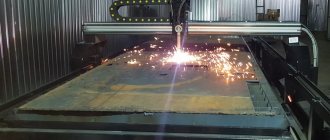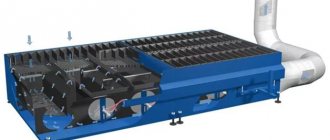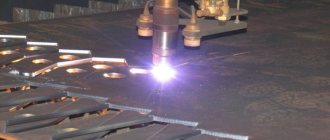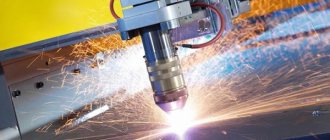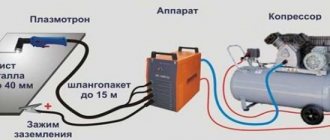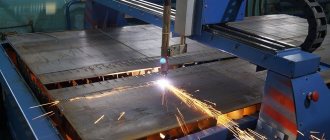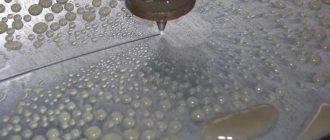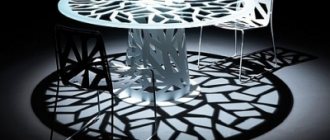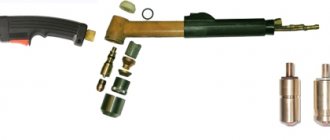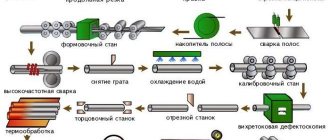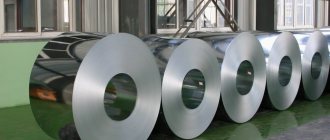Among the many cutting methods, plasma cutting of metals is considered one of the most popular. The technology is supported by special equipment - numerically controlled plasma cutters.
They are widely used in many industries. Using this machine, elements of building metal structures, parts for various equipment, components of agricultural machinery, metal doors, shelving for retail establishments are accurately and efficiently produced; ventilation devices for industry, many other products.
Plasma cutting and its features
The plasma cutting process is a unique technology for cutting sheet metal, which is applicable for structural, alloy steels, cast iron and non-ferrous metals (copper, aluminum, their alloys). It consists in compressing the plasma arc as it passes through the nozzle.
There are several cutting schemes:
- Plasma arc cutting is a more efficient technology that is used for processing electrically conductive materials. Here, a direct arc is formed when an electric current flows from the electrode to the metal being processed.
Figure 1. Direct arc
- Plasma jet cutting is used for cutting materials that are not electrically conductive. An indirect arc occurs between the cathode and the nozzle - i.e. The workpiece being cut is not included in the electrical circuit.
Figure 2. Indirect arc
Plasma arc cutting is considered one of the most economically effective methods for cutting sheet metal of small and medium thicknesses (up to 50 mm). When working with such material, a CNC plasma machine provides the highest quality and cutting accuracy. However, the error is small even when cutting thicker metal (up to 100 mm or more, depending on the type of equipment).
Plasma gases in the arc are partially dissociated and ionized, and therefore become electrically conductive. The increased energy density and temperature ensure the expansion of the plasma and its movement towards the workpiece at a speed exceeding almost 3 times the speed of sound. The high temperature of the plasma arc (up to 30 thousand K) in combination with high kinetic energy provides an increased cutting speed of metals.
The cutting process begins with the ignition of a pilot arc between the nozzle and the cathode, which causes partial ionization necessary to prepare the space between the plasmatron and the workpiece. It is ignited by supplying increased voltage. When it comes into contact with the material, the power automatically increases and the cutting arc ignites. The thermal energy of the arc melts and partially evaporates the metal. Under the influence of kinetic energy, the molten material is removed from the cutting zone.
Photo 3. Plasma arc cutting process
Features of the cutting process
When using plasma machines, you need to take into account their technical characteristics, the chemical composition of the mixtures used and the dimensions of the products.
If the metal sheets have a small thickness of up to one centimeter, then the temperature of a low-power plasma arc is sufficient. Sheets with greater thickness can be cut and further stabilized into an arc. When the sheet thickness is above ten centimeters, plasma devices that are capable of forming an arc with a more powerful effect will be required.
The type of source is also of great importance. For thin sheets of steel up to six millimeters, a small current is enough. To process sheets that are twice as thick, a high current source will be required.
Design and principle of operation of the equipment
For plasma cutting, a machine is used consisting of the following structural elements:
- Power supply - serves to supply current and voltage to ignite the pilot and cutting arc.
Photo 4. Appearance of the power supply
- Plasma torch is a device that generates plasma. In it, electric current is converted into a plasma arc. Its main structural elements are an electrode (aka cathode) with an insert made of refractory metal, a nozzle and a swirler. Typically, plasma torches are water-cooled. The cathode and nozzle are consumables, the frequency of replacement of which depends on the intensity of work, the type and thickness of the rolled metal being cut.
Photo 5. Appearance of the plasma torch
- Portal system - consists of a portal with longitudinal guides, a mechanism for the transverse movement of the plasma cutter. Movement is ensured by a rack and pinion drive; the portal is also equipped with a dynamic vibration protection system to increase the operational life of the complex and increase the quality of the cut.
Photo 6. Portal design without a desktop
- The coordinate table is a stable basis for laying the processed metal. Depending on the type of equipment, they can have different sizes - the standard width is from 1.5 to 8 m.
Photo 7. Automatic cutting complex with cutting table
- Numerical control system is a computerized system for automatic control of equipment drives. Includes a working console (for entering playback programs and controlling operating modes), an operator console (for visual monitoring of the work process) and a controller (for controlling moving equipment).
Photo 8. Appearance of the CNC system
The main operating parameters of the process are current strength, cutting speed, gap between the cutter nozzle and the workpiece, and the type of gas used. Air is considered the most accessible and simple plasma-forming gas, but it is optimal only for cutting carbon and stainless steels. Also, when using it, slight discoloration and nitriding of the edge is observed, which somewhat complicates subsequent machining due to an increase in hardness.
An equally important parameter is gas pressure. Choosing the optimal value ensures a long service life of the plasma torch consumables and high cut quality. However, when operating at elevated pressure, the service life of the cathode is reduced, and problems are observed at the beginning of the cutting process. Lower values lead to insufficient cooling of the plasma cutter, which can cause double arcing and even destruction of the nozzle.
The controller is responsible for moving the technological equipment of the portal system. But first, you need to load the control program developed by the technologist into the CNC system. The use of numerical control provides the ability to reproduce contours of any complexity.
The development of control programs is carried out for cutting both single workpieces and entire sets of parts of different sizes and shapes. Cutting cards are developed on a PC using special software. Initially, each part is drawn taking into account all allowances, then the blanks are laid out on a virtual sheet of metal of certain dimensions in special software. Thanks to this, rolled metal is used as rationally as possible and the amount of waste is minimized.
Advantages of the INCUT CNC-1530H, Integral machine
- Stable operation, high frequency effective plasma, lightweight portable design.
- Supports two cutting methods - gas flame and plasma.
- Economic advantages - design and design, easy to operate.
- High cutting quality, high repeatability of the contour of the cut parts.
- The most effective use of plasma cutting technology when cutting steel sheets up to 20-25 mm thick; for carbon steel thicknesses over 30 mm, it is advisable to use gas-flame technology.
- Built-in THC (Torch Height Control) system - a torch height adjustment system.
- Drawings made in CAD programs are the basis for creating a control program.
- The software allows you to save drawings in .dxf format, compatible with most design programs (such as AutoCAD, SolidWorks, Compass).
- Using the machine's software, computer graphics in .dxf format can be reduced to G-code.
- The machine is equipped with a USB interface for convenient transfer of the control program.
| Stepper motors | Gearbox | Gear |
| Rack | FastCam Software |
Advantages of the device
Plasma cutters or CNC plasma machines have the following advantages:
- High quality of cut - due to the use of high-quality plasma torches and the correct choice of plasma-forming gas, a small cut width, minimal angular deviation and clean edges without sagging and scale are ensured.
- Technological flexibility - suitable for straight and shaped cutting of various metals and alloys.
- Increased cutting speed - depending on the metal grade and thickness, it can reach up to 6 m/min.
- The minimal heat-affected zone, the directional effect of the plasma arc, makes it possible to cut blanks from thin sheet metal without thermal deformation.
- The low cost of the process is relevant when working with rolled sheets up to 50 mm thick.
- Short burn time, unlike air-oxygen cutting, which requires long preheating.
Photo 9. Automated cutting of sheet metal
Advantages of plasma cutting machines
Gantry plasma cutting installations are actively used in modern Russian industry.
Such devices are equipped with a unique configuration system that is very easy to master. Plasma cutting systems significantly simplify the work process. Equipment of this type is capable of processing a workpiece according to an established program, and the automatic system makes the necessary adjustments to create a product of the required size. Plasma equipment can be used to carry out various types of technological processes, increasing labor productivity. Pay attention to the main advantages:
- High cutting speed (depending on the thickness of the metal);
- Fast pierce increases operating speed and improves productivity;
- The plasma machine has a high cut quality;
- Versatility of work – processes different types of metal;
Plasma cutting techniques
CNC plasma cutting machines can be equipped with various additional functionality and systems. One of the most useful is automatic height control, since the gap between the nozzle and the material being processed affects the bevel of the edges. As the distance increases, the bevel angle also increases, and as the distance decreases, the service life of the electrode and nozzle decreases. Cutting while maintaining a constant height has a positive effect on the quality of edges and the service life of consumables.
The speed of movement of the plasma torch during operation should ensure that the cutting angle of the lower edge from the upper edge is no more than 3-5°.
When developing control programs, the technologist is recommended to adhere to the following requirements to ensure minimal deformations:
- The holes are cut first.
- Cutting blanks starts from one edge, sequentially moving from one part to another in the direction of the opposite edge.
- When developing cards for cutting a set of workpieces, combined cuts are used, in which the cutting line cuts 2 parts at once.
- Long blanks are located closer to the edge of the sheet, from which cutting will begin, and short ones - closer to the middle and the opposite edge.
- Cutting workpieces more than 3 m long and more than 0.5 m wide is performed from the corner, and starts from the long edge.
- The parts that occupy most of the sheet are cut out first.
Photo 10. The process of cutting out a part
Design features of INCUT CNC-1530H, Integral
CNC machine device
- Language support: English, Russian, Chinese.
- Library of standard parts: more than 40 standard blanks with variable sizes and types of parts (hole, part).
- Calibration of the rotation angle of the part relative to the sheet. The system can rotate a part (group of parts) relative to the sheet. It is enough to specify two points on the edge of the sheet and the entire coordinate system will unfold parallel to the sheet. You can also manually enter the rotation angle of the parts.
- Parts layout function. The operator, without the participation of a programming engineer, can reproduce parts on the CNC, indicating the required number of parts and the type of layout (matrix, checkerboard, cell).
- Ability to save completed programs in internal memory and USB storage. Ability to edit programs through a text editor.
Description of G and M codes
| Code | Function | Code | Function |
| G99 | Rotation Scale Mirror (XY) | G00 | Fast travel |
| G92 | Setting coordinates | G01 | Linear interpolation |
| G91 | Relative coordinate system | G02 | Circular interpolation clockwise |
| G90 | Absolute coordinate system | G03 | Circular interpolation counterclockwise |
| G20 | English system (in inches) | G04 | Program stop (pause) |
| G21 | Metric system (in millimeters) | M07 | Turning on cutting (plasma, gas) |
| G41 | Cutting width compensation on the left | M08 | Turn off cutting |
| G42 | Cutting width compensation on the right | M02 | End of the program |
| G40 | Canceling cutting width compensation |
Digital control
- Graphic display of cutting.
- 7″ widescreen LCD display
- Keyboard and operating mode buttons.
- Support work process pause, move forward, backward, speed control, etc.
- Function of returning parameters and automatic punching in case of failures.
- Manual/automatic control.
- Cutting distance compensation function.
- Automatic clutch (stepper motor shutdown button) - convenient to use, allows for quick positioning of the cutter.
- Air cooling fan with temperature sensor.
- Save up to 300 files (each file up to 2000 lines), up to 2 GB on U disk.
- High-speed 16-bit chip, can work from flash drives and external USB.
- High-grade stepper motor, smooth movements, low noise, high precision operations.
- The cutting speed can be set up to 3 m/min.
- Withstands high-frequency interference, adapted for all types of plasma sources.
- Simplified operation.
- Convenient control functions: memory return, torch change, cutting interruption, automatic clutch switching.
Software
FastCAM software based on AutoCAD. Used to output a control program from a DXF file. To optimize the layout of parts, the FastNest module is used. The software can help the user to carry out various drawings of complex parts. Using AutoCAD functions you can process the drawing into a DXF file, which automatically generates the cutting code.
Functions:
Using AutoCAD functions, you can process the drawing into a .dxf file, from which FastCFM automatically generates the cutting code.
Treatment:
setting the cutting point, the function of calculating the actual center for flame cutting, it can also determine the cutting direction and path - tool routing.
Methods:
in the software with the drawing of the part, you can rotate, copy, mirror, scale, etc. using advanced processing technology.
Simulation screen:
the cutting process can be simulated on the screen, cutting process routing and scale, tool movement
Plasmatron and oxygen gas cutter (included)
Application of settings
Due to high technological flexibility and productivity, CNC machines for plasma cutting are used mainly by large and medium-sized factories for the production of industrial equipment, metal structures, etc.
Plasma equipment with numerical control is used for cutting the following metals:
- Carbon steels - usually when cutting sheets up to 40-50 mm, compressed air is used, as well as nitrogen, mixtures based on nitrogen and oxygen.
- Low-carbon - for thicknesses up to 40 mm, compressed air is most effective, but when cutting rolled metal with a thickness of more than 20 mm, nitrogen and nitrogen-hydrogen mixtures can be used.
- Stainless steel - nitrogen is used (up to 20 mm), mixtures of nitrogen and hydrogen (up to 50 mm). Compressed air may be used.
- Steels with a high content of alloying elements - for thicknesses of 50-60 mm, air plasma cutting is used; for thicker sheets, nitrogen-oxygen mixtures are recommended.
- Copper and its alloys – compressed air is suitable for processing rolled metal of small and medium thicknesses. When used, a burr is formed on the edges, but excess metal is easily removed from the surface. Nitrogen is suitable for cutting workpieces with a thickness of 5 to 15 mm. Brass is cut with the same gases, but at higher speeds (up to 20-25%). It should also be taken into account that copper has high thermal conductivity and heat capacity, so work requires a more powerful arc than for processing steel.
- Aluminum and alloys based on it - compressed air is usually used exclusively for separation cutting with the obligatory subsequent machining of parts. At the same time, high-quality cuts are possible only when cutting products up to 30 mm thick at an operating current of up to 200 A. Also, for cutting sheets up to 20 mm, nitrogen can be used, from 20 to 100 mm mixtures of nitrogen and hydrogen, more than 100 mm - argon-hydrogen mixtures .
Photo 11. Cutting blanks from aluminum sheet
What are the benefits of installing a plasma machine at an enterprise?
The use of this type of equipment increases the speed and quality of cutting various types of metal. This can be painted or dirty low carbon steel. It should be noted that the thickness of the metal sheet can be either more than 35 mm or thinner. The gantry cutting machine uses electricity and compressed air. For the device to function, there is no need to spend money on gas cylinders, which leads to financial savings.
The owner of the enterprise will be able to get rid of additional costs for each meter of metal processing, increasing the profitability of the production process. The simplicity of operations allows the master to quickly master the necessary skills to operate a thermal cutting machine. This type of equipment is a smart investment that increases the quality of operations.
Each model is capable of taking a plant's production process to a new level, reducing metal cutting costs. Another advantage of this type of product is the ability to process products of complex shapes. High safety, which is a consequence of the absence of explosive cylinders with oxygen, acetylene or propane-butane, is another important advantage for purchasing a gantry machine. Plasma cutting is a modern and progressive method of metal processing.
Anyone can purchase products from the following brands: ECKERT, HASA CS, Galaxy, SQL4, Sapphire BL2, Jantar2.
Each plasma installation meets modern quality standards and has a certificate. You can be confident in the reliability of the equipment.
Types of machines
Plasma equipment with numerical control is produced in several types:
- Portable – installations of relatively small size, on which you can cut rolled metal of limited dimensions. Typically, the width of their working area is 1.5-3 m. If desired, such devices can be moved within the workshop or to another production site or facility.
Photo 12. Portable plasma cutting device
- Stationary – powerful automated lines with a coordinate table width of up to 8 m. They are installed permanently, movement is possible only with prior dismantling using special lifting equipment.
Photo 13. Stationary machine
Cost of CNC machines
Prices for CNC plasma machines vary widely. It all depends on the type and technical characteristics of the equipment, functionality, and overall dimensions of the working area.
The cost of a full-fledged automatic line starts from 1.5 million rubles. However, for most machines, the price is determined upon request, taking into account the individual needs of the customer, the expected types of work, installation configuration and other parameters.
Additionally, the total price may include costs for auxiliary equipment (compressors, ventilation system), as well as services such as installation, commissioning, personnel training, maintenance, etc.
Equipment Manufacturers
Today, plasma CNCs are produced by both foreign and domestic manufacturers. There are cars on sale in different price categories, but what costs more is not always of higher quality.
The domestic manufacturer PURM develops and produces CNC plasma machines taking into account the harsh Russian operating conditions. Equipment of this brand is successfully used by enterprises in central Russia and even in the Far North.
Photo 14. Equipment of the domestic manufacturer PURM
The company is engaged not only in the manufacture of installations, but also in the supply of spare parts, consumables, and components. If desired, you can order installation supervision, commissioning, and post-warranty service.
How to choose a CNC machine?
To choose the right CNC plasma machine, you need to decide on the following points:
- Types of work - only straight cutting or with the possibility of cutting out parts of complex configurations.
- Maximum dimensions of sheet metal - the dimensions of the working area of the coordinate table depend on this.
- Maximum Material Thickness – Determines the wattage rating of the power source and the type of cutting gas used.
Photo 15. Cutting out a single part
One of the main characteristics of the equipment is the on-time (or duty cycle). This parameter determines the intensity of operation, namely the time period during which the machine can operate without interruptions for cooling.
PV is indicated as a percentage - if the on-time is 80%, this means that during a 10-minute operating cycle the installation can operate for 8 minutes at maximum loads. If this norm is exceeded, it may overheat and fail. However, most industrial CNC plasma cutters have a 100% duty cycle and are therefore designed for continuous operation throughout the entire work shift.
An equally important characteristic of the installations is the current supplied by the power source - it is this that determines the maximum thickness of the processed metal.
What's in the plasma cutter review?
Enterprises in various industries use:
- stationary models, among them there are portal machines; articulated; console type for cutting metal using plasma;
- mobile or portable for the same purpose (vertical plasma cutting), equipped with CNC systems.
Today it is not difficult to make a choice of a plasma machine - there are many manufacturers specializing in the manufacture of devices of this kind. The range is represented by domestic and foreign models. Let us name and briefly describe at least some of them:
- The PlasmaCut installation from the Russian company Unimash is aimed at being used in medium and small businesses. The Hypertherm plasma source is one of the most technologically advanced; it has a FOCUT mechanism that controls the torch height and powerful motors. It can be controlled remotely via USB and Ethernet from the rack on which the control panel is mounted.
- The IGNIS CNC plasma cutting machine (Russia) has several modifications - IGNIS 2500, 3000 and 6000 with different dimensions, power of the plasma source and load capacity. All of them are designed for use with a metal thickness of 28 mm, have a stable demand and are applicable in the technical equipment of small-scale workshops and enterprises.
- Powermax is considered a machine with unique properties, capable of performing plasma cutting of products of various types and shapes.
- PlasmaBox is an excellent machine from a series of multi-axis machines, it has four motors operating with different powers.
- РВ 6000, РМ 3000, PS 2500 – units that cut workpieces of different lengths and thicknesses.
All of these high-performance machines use an AMN CNC control system. In some models for industrial use, the plasma torch is cooled forcibly under the influence of liquid, while others have natural air cooling.
It should also be said that the weak point of computer-controlled machines is their vulnerability to the effects of electromagnetic radiation. This makes CNC devices demanding in terms of the method of igniting the electric arc. The safest option is pneumatic ignition, sometimes referred to in the names of device models as PN. The main feature of pneumatic ignition is a movable electrode, which moves towards the nozzle at the right moment. By reducing the distance to initiate the arc, high-frequency pulses are not required and interference to the electronics is minimized. Today there are not many devices with pneumatic ignition on the market; for example, it is implemented in the Triton CUT 100 PN CNC plasma cutter.
Major machine breakdowns
When operating CNC plasma machines, there are no particular problems with their performance. However, there are several factors that can contribute to the equipment not functioning properly:
- A short circuit in the electrical network can cause the main control boards to burn out.
- Voltage fluctuations, if they exceed the range established by the manufacturer, can also lead to failure of electrical components.
- Physical wear of mechanisms or excessive exceeding of the established service life of parts.
Photo 16. Cutting thin sheet metal
Any malfunctions in the operation of the plasma cutter can be eliminated in a short time, but it is better to perform timely maintenance, change parts with high wear and consumables. This will ensure its stable operation, high productivity and cutting quality.
